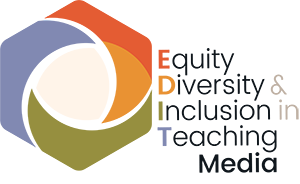The EDIT 10: Best Practices For Inclusive Teaching in Media Production
This document was created by media faculty for media faculty based on research conducted on U.S. higher education media production classrooms. We call our faculty-led initiative EDIT Media (Equity, Diversity, and Inclusion in Teaching Media) and the EDIT 10 was developed collaboratively with faculty, students, and alumni of production programs. EDIT Media’s impetus in developing this document began in department meetings, at conferences, and in student conversations about recurring problems in production classes: frustration with gender, racial, economic, and other imbalances in the classroom; students’ desire to see a wider array of mediamakers, actors, and characters in examples presented in class; and shared concerns across campuses and at festivals over stereotypical characters, gratuitous violence, and clichéd narratives in student work.
EDIT Media’s methodology in developing these practices included researching scholarship on media production practices, media literacy, and inclusive pedagogy; in-person focus groups with faculty and students across the country representing a variety of institutions and experiences; and anonymous national surveys of faculty and students in media production programs.
Change is needed if faculty are to fairly and equitably engage all of the students in our classrooms. Of 149 media faculty surveyed about inclusive teaching practices in media production higher education programs, 90.5% stated that more was needed from programs to ensure that all students feel equally valued and fully participate.* (More specifically, 24% said some improvement is needed, 42% said there was “lots of room to improve,” 22.1% said “quite a lot” of improvement is still needed, and 1.3% stated that programs were very poor at inclusion.)
Students concur. In our survey of 152 students, 26% answered “yes” when asked whether they had ever felt excluded from or uncomfortable with a project or discussion in their production classes because of their identity.** Of those “yes” responses, the most often-cited causes for a feeling of marginalization were that “Film/TV examples shown or discussed in class rarely portrayed people like me” (17%), “Other students in the class said insensitive things about my identity” (16%), or “I felt intimidated because of my skill level with equipment or software” (13%).
In this research, we repeatedly heard stories of both faculty and students replicating the same kinds of biases in front of and behind the camera that are plaguing the American media industries. As instructors, we are in a position not only to support our students in producing richer and more diverse creative work, but to launch them into careers as leaders creating more inclusive workplaces. Graduates entering these fields can make transformative change. To get there, students on this career path need the best education possible – an education based on best practices.
With that in mind, the EDIT 10 builds upon research and feedback shared about faculty and student experiences in the classroom. These Best Practices allow each faculty member to teach to their expertise, to have autonomy in the classroom, and to foster students’ creativity. They are not intended to provide solutions, but rather to provide a framework for teaching media in a way that addresses the needs of a diverse and ever-evolving student body. The practices are holistic and interdependent—one practice does not exist as an answer in and of itself, but is in conversation with all other practices. This is a living document that will change and grow. We hope the EDIT 5 will encourage rich conversations between faculty, administrators, staff, and students about how best our programs can succeed.
Explore this website for teaching resources, data, and articles to help guide faculty on how to implement each of these Best Practices in the classroom.
Download a printable version of this document here.
Download the Student 7
A companion document to these Best Practices for sharing with students, the Student 7 is designed to be used in conjunction with a discussion on collaboration and inclusive learning.

